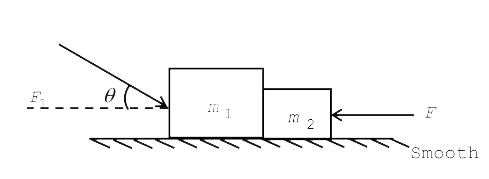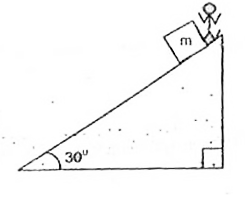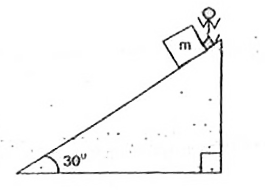Consider the following statemnts
When applied force F exceeds(fs)max the body begins to slide on the surface
When relative motion has started frictional force decreases from(fs)max.Choose the correct option
Only statement I is correct
Only statement II Is correct
Both statements I and II are correct
None of the above
The correct Answer is:C
To solve the question, we need to analyze the two statements regarding friction:
1. Statement 1: When the applied force F exceeds (fs)max, the body begins to slide on the surface.
2. Statement 2: When relative motion has started, the frictional force decreases from (fs)max.
Step 1: Understanding Static Friction
- Static friction is the force that prevents an object from moving when a force is applied. The maximum static friction force is denoted as (fs)max.
- The object will remain at rest as long as the applied force F is less than or equal to (fs)max.
Step 2: Analyzing Statement 1
- According to the first statement, if the applied force F exceeds (fs)max, the static friction can no longer hold the object in place, and it will start to slide.
- This statement is correct because it accurately describes the transition from static to kinetic friction.
Step 3: Understanding Kinetic Friction
- Once the object starts sliding, static friction is no longer applicable; instead, kinetic friction comes into play.
- Kinetic friction is usually less than the maximum static friction, meaning the frictional force acting on the sliding object will be lower than (fs)max.
Step 4: Analyzing Statement 2
- The second statement claims that when relative motion has started, the frictional force decreases from (fs)max.
- This is also correct because once the object is in motion, the frictional force acting on it is the kinetic friction, which is less than (fs)max.
Step 5: Conclusion
- Both statements are correct. Therefore, the correct option is that both statements are true.
Final Answer:
Both statements are correct. The correct option is C.
2. Statement 2: When relative motion has started, the frictional force decreases from (fs)max.
- Static friction is the force that prevents an object from moving when a force is applied. The maximum static friction force is denoted as (fs)max.
- The object will remain at rest as long as the applied force F is less than or equal to (fs)max.
- According to the first statement, if the applied force F exceeds (fs)max, the static friction can no longer hold the object in place, and it will start to slide.
- This statement is correct because it accurately describes the transition from static to kinetic friction.
- Once the object starts sliding, static friction is no longer applicable; instead, kinetic friction comes into play.
- Kinetic friction is usually less than the maximum static friction, meaning the frictional force acting on the sliding object will be lower than (fs)max.
- The second statement claims that when relative motion has started, the frictional force decreases from (fs)max.
- This is also correct because once the object is in motion, the frictional force acting on it is the kinetic friction, which is less than (fs)max.
- Both statements are correct. Therefore, the correct option is that both statements are true.
Both statements are correct. The correct option is C.
Similar Questions
In the figure shown, horizontal force F1 is applied on a block but the block does not slide. Then as the magnitude of vertical force F2 is increased from zero the block begins to slide, the correct statement is

View SolutionChoose the correct options –
(1) Friction always opposes the motion
(2) Friction may opposes the motion
(3) If the applied force is increased the force of static friction remains constant.
(4) If the applied force is increased the force of static friction also increases upto limiting friction.
View Solution
Knowledge Check
Consider the following statemnts
When applied force F exceeds(fs)max the body begins to slide on the surface
When relative motion has started frictional force decreases from(fs)max.Choose the correct optionAOnly statement I is correctBOnly statement II Is correctCBoth statements I and II are correctDNone of the aboveConsider the following statements
The motion of the CM depends upon the external forces,
The vector sum of internal forces of a system is zero. Choose the correct option.AOnly IBOnly IICBoth I and IIDNone of theseA force given by the relation F = 8t, (F in Newton and t in sec.) acts on a body of mass 2kg. Initially at rest. Choose the correct option.
APower of force is continuous increasing.BThe work done by this force on the body during first 2 seconds of its motion is 64 J.CVelocity at 2 seconds after beginning of motion is 8 m/s.DPower of force is constant.
Two forces are applied on a system of blocks as shown. The block remains in equilibrium on the smooth surface. Then choose the correct option(s).

View SolutionWhen we apply a horizontal force on a body kept on horizontal floor, a horizontal force starts opposing the net applied force. This force is called frictional force and is always tangential to the contact surface. Frictional force on a moving body is called kinetic friction which is directly proportional to the normal force (fk=μkN) where μk is a constant depending upon the surfaces and is called the coefficient of kinetic friction. Frictional force on a static body is called static friction. Maximum value of static friction force is (fs≤μsN), where μs is coefficient of static friction.

Now a man wants to slide down a block of mass m which is kept on a fixed inclined plane of inclination 30∘ as shown in figure initially, the block is not sliding. To just start sliding the man pushes the block down the inclined with a force F. Now the block starts accelerating. To move it downwards with constant speed, the man starts pulling the block with same force. Surfaces are such that ratio of maximum static friction to kinetic friction is 2. Now, answer the following questions.
If man continues pushing the block by force F, its acceleration would be
View SolutionWhen we apply a horizontal force on a body kept on horizontal floor, a horizontal force starts opposing the net applied force. This force is called frictional force and is always tangential to the contact surface. Frictional force on a moving body is called kinetic friction which is directly proportional to the normal force (fk=μkN) where μk is a constant depending upon the surfaces and is called the coefficient of kinetic friction. Frictional force on a static body is called static friction. Maximum value of static friction force is (fs≤μsN), where μs is coefficient of static friction.

Now a man wants to slide down a block of mass m which is kept on a fixed inclined plane of inclination 30∘ as shown in figure initially, the block is not sliding. To just start sliding the man pushes the block down the inclined with a force F. Now the block starts accelerating. To move it downwards with constant speed, the man starts pulling the block with same force. Surfaces are such that ratio of maximum static friction to kinetic friction is 2. Now, answer the following questions.
What is the value of F?
View SolutionWhen we apply a horizontal force on a body kept on horizontal floor, a horizontal force starts opposing the net applied force. This force is called frictional force and is always tangential to the contact surface. Frictional force on a moving body is called kinetic friction which is directly proportional to the normal force (fk=μkN) where μk is a constant depending upon the surfaces and is called the coefficient of kinetic friction. Frictional force on a static body is called static friction. Maximum value of static friction force is (fs≤μsN), where μs is coefficient of static friction.

Now a man wants to slide down a block of mass m which is kept on a fixed inclined plane of inclination 30∘ as shown in figure initially, the block is not sliding. To just start sliding the man pushes the block down the inclined with a force F. Now the block starts accelerating. To move it downwards with constant speed, the man starts pulling the block with same force. Surfaces are such that ratio of maximum static friction to kinetic friction is 2. Now, answer the following questions.
What is the value of μs ?
View SolutionA block of mass M rests on a rough horizontal table. A steadily increasing horizontal force is applied such that the block starts to slide on the table without toppling. The force is contained even after sliding has started. Assume the coefficients of static end kinetic friction between the table and block to be equal. The correct representation of the variation of the frictional force , f1 exerted by the table on the block with time t is given by -
View Solution